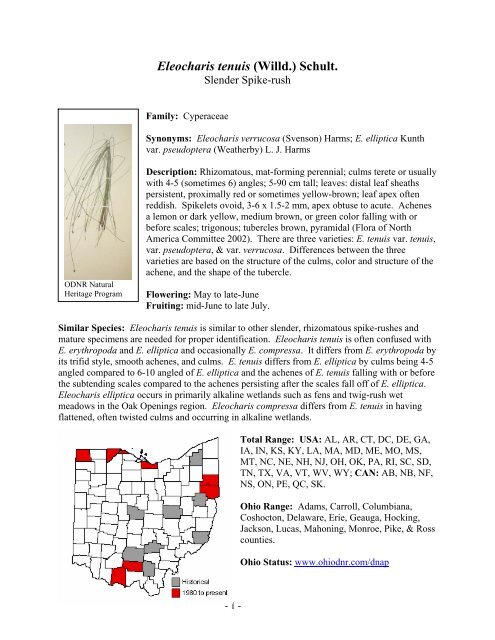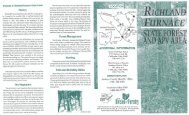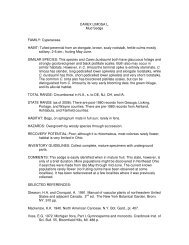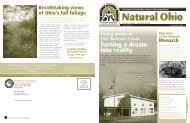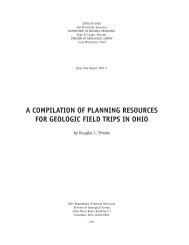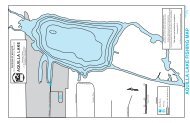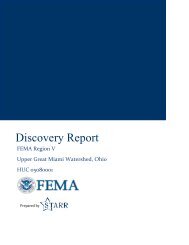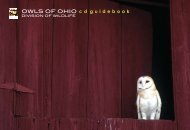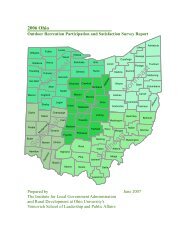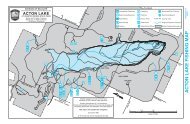Eleocharis tenuis
Eleocharis tenuis
Eleocharis tenuis
You also want an ePaper? Increase the reach of your titles
YUMPU automatically turns print PDFs into web optimized ePapers that Google loves.
<strong>Eleocharis</strong> <strong>tenuis</strong> (Willd.) Schult.Slender Spike-rushFamily: CyperaceaeSynonyms: <strong>Eleocharis</strong> verrucosa (Svenson) Harms; E. elliptica Kunthvar. pseudoptera (Weatherby) L. J. HarmsODNR NaturalHeritage ProgramDescription: Rhizomatous, mat-forming perennial; culms terete or usuallywith 4-5 (sometimes 6) angles; 5-90 cm tall; leaves: distal leaf sheathspersistent, proximally red or sometimes yellow-brown; leaf apex oftenreddish. Spikelets ovoid, 3-6 x 1.5-2 mm, apex obtuse to acute. Achenesa lemon or dark yellow, medium brown, or green color falling with orbefore scales; trigonous; tubercles brown, pyramidal (Flora of NorthAmerica Committee 2002). There are three varieties: E. <strong>tenuis</strong> var. <strong>tenuis</strong>,var. pseudoptera, & var. verrucosa. Differences between the threevarieties are based on the structure of the culms, color and structure of theachene, and the shape of the tubercle.Flowering: May to late-JuneFruiting: mid-June to late July.Similar Species: <strong>Eleocharis</strong> <strong>tenuis</strong> is similar to other slender, rhizomatous spike-rushes andmature specimens are needed for proper identification. <strong>Eleocharis</strong> <strong>tenuis</strong> is often confused withE. erythropoda and E. elliptica and occasionally E. compressa. It differs from E. erythropoda byits trifid style, smooth achenes, and culms. E. <strong>tenuis</strong> differs from E. elliptica by culms being 4-5angled compared to 6-10 angled of E. elliptica and the achenes of E. <strong>tenuis</strong> falling with or beforethe subtending scales compared to the achenes persisting after the scales fall off of E. elliptica.<strong>Eleocharis</strong> elliptica occurs in primarily alkaline wetlands such as fens and twig-rush wetmeadows in the Oak Openings region. <strong>Eleocharis</strong> compressa differs from E. <strong>tenuis</strong> in havingflattened, often twisted culms and occurring in alkaline wetlands.Total Range: USA: AL, AR, CT, DC, DE, GA,IA, IN, KS, KY, LA, MA, MD, ME, MO, MS,MT, NC, NE, NH, NJ, OH, OK, PA, RI, SC, SD,TN, TX, VA, VT, WV, WY; CAN: AB, NB, NF,NS, ON, PE, QC, SK.Ohio Range: Adams, Carroll, Columbiana,Coshocton, Delaware, Erie, Geauga, Hocking,Jackson, Lucas, Mahoning, Monroe, Pike, & Rosscounties.Ohio Status: www.ohiodnr.com/dnap- 1 -
Habitats: Moist soils in xeric limestone prairies; wet meadows, shores of ponds, ditches, &disturbed moist, habitats.Threats: Shading by native and non-native shrubs and trees and taller herbaceous vegetation.Herbaceous invasive plants, Phragmites australis, Phalaris arundinacea, and Typha angustifoliaare serious threats.Conservation Potential: This species occurs in a variety of open, wet habitats scattered aroundthe state. At some localities, it can form extensive colonies. As of 2006, 4 sites occur on privateand public conservation lands. Two of these sites are being actively managed to improve habitatfor this species. It can tolerate moderate disturbances.Inventory Guidelines: Mature achenes are essential for conclusive identification especiallybetween varieties. Complete specimens with rhizome are recommended for properidentification. Photographs are inconclusive.Comments: All three varieties have been documented in Ohio and several specimens cannot bedetermined to variety. Ohio Natural Heritage Program monitors E. <strong>tenuis</strong> (all varieties) as aresult of difficulty in determining some specimens to variety. E. <strong>tenuis</strong> is a complex group andintermediates are common, however extremes of the three varieties are distinctive. The mostcommon variety in Ohio is variety verrucosa. This variety is western in range and is widelyscattered in the state. It has been documented from 8 counties in Ohio.A couple specimens collected by Floyd Bartley from “Higby Prairie” in Ross County wererecently determined as possibly <strong>Eleocharis</strong> <strong>tenuis</strong> var. pseudoptera by S. Galen Smith for hisFlora of North America treatment. The typical variety, variety <strong>tenuis</strong>, is mostly found along theAtlantic coast with scattered localities inland. In Ohio, it is known only from a single collectionin Monroe County. Braun (1967) reports E. <strong>tenuis</strong> from Auglaize, Clermont, Cuyahoga, andHamilton counties. These reports have not been verified.Presumed hybrids between E. <strong>tenuis</strong> and E. erythropoda and E. elliptica have been reported andare discussed by S. Galen Smith in Flora of North America (2002). There are Ohio specimensintermediate between E. <strong>tenuis</strong> and E. elliptica.The status of this species has been under review for six years. In that time, staff and fellow fieldbotanists located only one new population. The species was added in 2006 with statusundetermined.The ecology of this species in Ohio is rather unknown. Current known localities are open, wetmeadows and mudflats not dominated by taller, perennial species.<strong>Eleocharis</strong> <strong>tenuis</strong> should be more frequent than current records indicate and it should be soughtthroughout the state.- 2 -
Selected References:Braun, E.L. 1967. The Monocotyledoneae [of Ohio]. Cat-tail to orchids. Ohio State UniversityPress, Columbus, OH. ix + 464 p.Crow, G.E. & C.B. Hellquist. 2000. Aquatic and wetland plants of Northeastern NorthAmerica. Vol. 2. Angiosperms: Monocotyledons. The University of Wisconsin Press,Madison, WI. 456 p.Flora of North America Editorial Committee, eds. 2002. Flora of North America north ofMexico. Vol. 23. New York and Oxford.Harms, L. 1972. Cytotaxonomy of the <strong>Eleocharis</strong> <strong>tenuis</strong> complex. Am. J. Bot. 59: 483-487.Svenson, H.K. 1957. Scirpeae (continuato). N. Am. Flora 18:505-556 [<strong>Eleocharis</strong>, pp. 509-540].Voss, E.G. 1972. Michigan flora, Part I, Gymnosperms and monocots. Cranbook Inst. of Sci.Bull. 55, Bloomfield Hills, MI. 488 pp.Ohio Natural Heritage ProgramODNR Division of Natural Areas & Preserves2045 Morse Road, Building F-1Columbus, Ohio 43229www.ohiodnr.com/dnapLast updated: Dec/2007- 3 -


